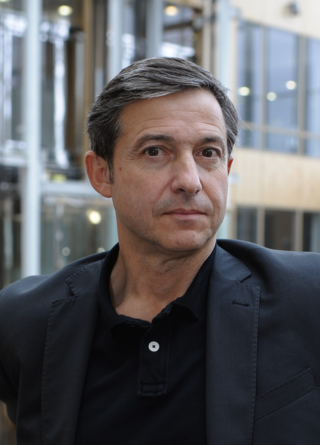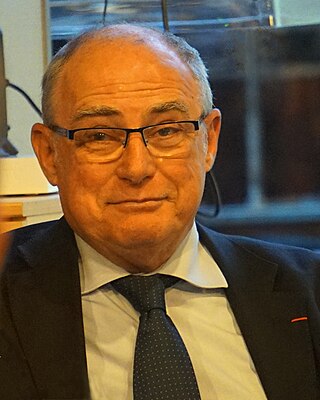
Erving Goffman was a Canadian-born American sociologist, social psychologist, and writer, considered by some "the most influential American sociologist of the twentieth century".

Claude Simon was a French novelist, and was awarded the 1985 Nobel Prize in Literature.

The Prix Théophraste-Renaudot or Prix Renaudot is a French literary award.

Edgar Morin is a French philosopher and sociologist of the theory of information who has been recognized for his work on complexity and "complex thought", and for his scholarly contributions to such diverse fields as media studies, politics, sociology, visual anthropology, ecology, education, and systems biology. As he explains: He holds two bachelors: one in history and geography and one in law. He never did a Ph.D. Though less well known in the anglophone world due to the limited availability of English translations of his over 60 books, Morin is renowned in the French-speaking world, Europe, and Latin America.
The Prix Valery Larbaud is a French literary prize created in 1967, ten years after writer Valery Larbaud's death, by L'Association Internationale des Amis de Valery Larbaud, an organization dedicated to the promotion of his works. The prize is awarded to writers of books the jurists feel "that Larbaud would have loved". It is always awarded in Vichy on the last weekend in May.

Chloé Delaume is a French novelist, performer, musician, and occasional singer.
Ray L. Birdwhistell was an American anthropologist who founded kinesics as a field of inquiry and research. Birdwhistell coined the term kinesics, meaning "facial expression, gestures, posture and gait, and visible arm and body movements". He estimated that "no more than 30 to 35 percent of the social meaning of a conversation or an interaction is carried by the words." Stated more broadly, he argued that "words are not the only containers of social knowledge." He proposed other technical terms, including kineme, and many others less frequently used today. Birdwhistell had at least as much impact on the study of language and social interaction generally as just nonverbal communication because he was interested in the study of communication more broadly than is often recognized. Birdwhistell understood body movements to be culturally patterned rather than universal. His students were required to read widely, sources not only in communication but also anthropology and linguistics. "Birdwhistell himself was deeply disappointed that his general communicative interests and goals were not appropriately understood." Collaborations with others, including initially Margaret Mead and Gregory Bateson, and later, Erving Goffman and Dell Hymes had huge influence on his work. For example, the book he is best known for, Kinesics and Context, "would not have appeared if it had not been envisaged by Erving Goffman" and he explicitly stated "the paramount and sustaining influence upon my work has been that of anthropological linguistics", a tradition most directly represented at the University of Pennsylvania by Hymes.
Hubert Damisch, was a French philosopher specialised in aesthetics and art history, and professor at the École des Hautes Études en Sciences Sociales (EHESS) in Paris from 1975 until 1996.

The Albert Londres Prize is the highest French journalism award, named in honor of journalist Albert Londres. Created in 1932, it was first awarded in 1933 and is considered the French equivalent of the Pulitzer Prize. Three laureates are awarded each year. The three categories are : "best reporter in the written press", "best audiovisual reporter" and "best reporting book".

Didier Fassin, born in 1955, is a French anthropologist and sociologist. He is the James D. Wolfensohn Professor of Social Science at the Institute for Advanced Study in Princeton and holds a Direction of Studies in Political and Moral Anthropology at the École des Hautes Études en Sciences Sociales in Paris. He has been appointed to the Chair of Public Health at the Collège de France. Fassin was elected to the American Philosophical Society in 2022.

Laure Adler is a French journalist, writer, publisher and radio/TV producer.

Jean Bollack was a French philosopher, philologist and literary critic.

Maurice Sartre is a French historian, an Emeritus professor of ancient history at the François Rabelais University, a specialist in ancient Greek and Eastern Roman history, especially the Hellenized Middle East, from Alexander to Islamic conquests.

Georges Bensoussan is a French historian. Bensoussan was born in Morocco. He is the editor of the Revue d'histoire de la Shoah. He won the Memory of the Shoah Prize from the Jacob Buchman Foundation in 2008.
Anti-urbanism is hostility toward the city as opposed to the country, a simple rejection of the city -- a wish to destroy the city. This hostility is not an individual sentiment, but a collective trope, sometimes evoked by the expression "urbophobia" or "urbanophobia" This trope can become politicized and thus influence spatial planning. Antiurbanism, while, of course, appearing within different cultures for different political purposes, is a global concept
Jean-Pierre Dupuy is a French engineer and philosopher.
Nicolas Lebourg is a French historian who specializes on far-right movements in Europe.

Armand Hatchuel is a French researcher and professor of management science and design theory at the Centre for Management Science, Ecole des Mines de Paris. A pioneer in the study of the cognitive and organizational dynamics at play in innovative enterprises, he is behind the development of several theories aimed at re-establishing management science as a fundamental science of collective action.
François Bédarida, was a French academic historian. His work centred on Victorian England and France in WWII. He made significant research contributions to the study of The Holocaust. He was a director of the Maison française in Oxford among other leadership roles.
Enchantment is a term widely used to describe something delightful, possibly magical, that causes a feeling of wonder. It has been adapted by a range of scholars across multiple disciplines, especially anthropology and sociology, and then later urban studies, to describe the ways in which people create moments of wonder in the midst of everyday life. British anthropologist Alfred Gell described art as "the technology of enchantment," permitting us to "see the real world in an enchanted form". American sociologist George Ritzer uses the term enchantment in his analysis of consumerism and McDonaldization, making the argument that "enchantment of the consumer is necessary for the spell to work".












